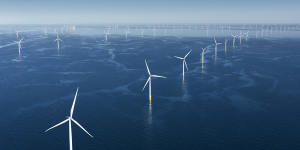AGL,the largest Australian electricity generator,is part of a global consortium that secured one of six federal permits on Wednesday,authorising it to conduct feasibility studies in an area off the Gippsland coast,where it wants to build one of the nation’s first offshore wind farms.

The federal government has selected sites for the first wind farms off the Gippsland coast. The projects could one day resemble this Danish wind farm.Supplied
If feasibility is proven and a commercial licence is obtained,AGL and its partners in the Gippsland Skies consortium say their project could turn offshore wind into enough electricity to light 1.4 million Victorian homes,or 17 per cent of the state’s annual demand.
AGL chief operating officer Markus Brokhof said the addition of offshore wind – an energy source that can supply electricity more consistently and reliably than land-based wind farms – would have a key role in AGL’s plans to dramatically expand its portfolio of new “firmed” renewable energy capacity in time for the closure of its last-remaining coal-fired plant in Victoria’s Latrobe Valley in the 2030s.
“Gippsland Skies will be an important part of AGL’s ambition to add 12 gigawatts of additional renewable and firming capacity by the end of 2035,” Brokhof said.
“The development of this significant offshore wind project could also be an ideal complement to the transition of AGL’s Loy Yang Power Station into the Latrobe Valley Energy Hub.”
AGL’s power stations are among Australia’s biggest sources of planet-warming greenhouse gas emissions.
Under pressure from investors,including billionaire climate activist Mike Cannon-Brookes,AGL in 2022 agreed to bring forward its exit from coal by up to 10 years to 2035 and boost spending on renewables.
Part of its strategy also includes long-term plans to diversify its retiring coal sites into hubs for lower-carbon energy sources spanning renewable energy generation,big batteries and green tech manufacturing.
Brokhof said the build-out of new infrastructure,skills and supply chains in Gippsland would be critical. “We hope to create a new era of innovation and new careers for the Gippsland region,” he said.
Another partner in the Gippsland Skies consortium,Direct Infrastructure,chaired by former Woodside Energy chief executive Peter Coleman,said the project brought together a significant track record of global offshore wind development with deep Australian energy industry expertise.
Coleman said the project would invest in regional and national supply chains and was exploring opportunities with local TAFE colleges and universities.
Gippsland,east of Melbourne,has long been central to Victoria’s energy generation as it is home to the state’s three remaining coal-fired power stations.
The area off the Gippsland coast is considered world-class for its untapped energy potential. The strong and consistent wind speeds and relatively shallow ocean areas less than 60 metres deep make it an ideal location to host large fixed-bottom offshore wind farms.
Proponents of offshore wind power say situating turbines way out at sea could reduce the risk of developments facing objections from nearby communities concerned about visual and environmental impacts.
Star of the South,a proposed 2.2-gigawatt wind farm off the Gippsland coast,whose backers include Copenhagen Infrastructure Partners (CIP) and Australian superannuation fund Cbus,is the most advanced Australian offshore wind farm plan.
On Wednesday,CIP unveiled a new company called Southerly Ten to oversee Star of the South,and another wind farm project off Gippsland,Kut-Wut Brataualung,both of which gained feasibility licences.
“These licences signal that Australia is open for business and open to the economic opportunities offshore wind can provide for our regional communities,” Southerly Ten chief executive Charles Rattray said.
“Offshore wind will play a vital role alongside other forms of generation in giving households and businesses the secure,reliable electricity they need and deserve.”
The Victorian government aims to source about two gigawatts – or 20 per cent of the state’s total power needs – from offshore wind by 2032,before doubling it to four gigawatts by 2035 and nine gigawatts by 2040.
Federal Climate Change and Energy Minister Chris Bowen said Australia’s nascent offshore wind industry presented a huge opportunity for regions such as Gippsland that had “powered our country for generations”.
“Australia’s first offshore wind zone has hit a new milestone,with reliable renewables and secure jobs a step closer for Gippsland,” Bowen said.
The Business Briefing newsletter delivers major stories,exclusive coverage and expert opinion..